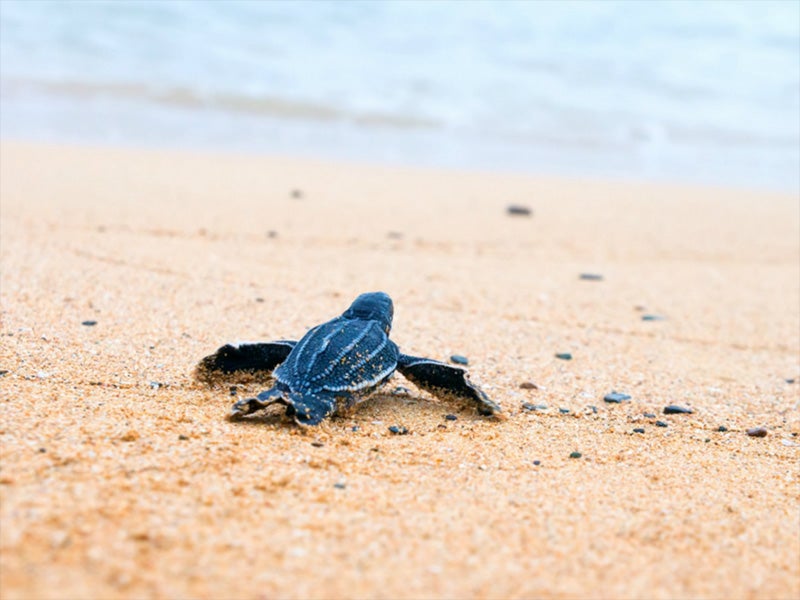Animal Magnetism: Sea turtles may follow Earth’s pull to navigate home
We’re fighting to protect the Gulf’s imperiled species as oil and gas corporations run freighters through precious habitat, drill deeper, and blast along the Gulf floor.
Every time a sea turtle emerges from the Gulf of Mexico to lay her eggs on a dark beach at night, a natural mystery unfolds.
For years, scientists didn’t know where the turtles went after they left land, or how they found their way back to nest on the beaches where they were born. Researchers now believe sea turtles may be physiologically in tune with Earth’s molten metal core, and that guides them back to the specific magnetic signature of the area where they hatched. One thing is sure: the Gulf of Mexico’s warm waters are a global sea turtle hot spot, with five of the world’s seven sea turtle species found there — loggerheads, leatherbacks, hawksbills, kemp’s ridleys, and green sea turtles. All are on the federal endangered species list.
Female sea turtles roam the seas for hundreds — even thousands — of miles for 10 to 25 years after they hatch, then mate and head back to their “home beach” to lay eggs. As for the males, after they hatch and head into the waves, they don’t typically set a flipper on land again.
These migrations are eons old, but now the Gulf that sea turtles swim through is a busy place. Sea turtles have to navigate a hazardous industrial zone created by oil and gas drilling, facing torturous underwater air gun blasts as loud as jet engines, suffocating oil spills, marine pollution, and looming ships.
Pressure by the oil industry to drill deeper and farther from the coastline makes the chances of a catastrophic spill worse. Yet government oversight isn’t reflecting that reality. And that’s why we’re in court to protect sea turtles and other imperiled Gulf species.
The Endangered Species Act requires the National Marine Fisheries Service to do a formal “biological opinion” on the risk to endangered and threatened species from Gulf oil and gas exploration and drilling. The Trump Administration issued its biological opinion in April 2020, and it is still in effect now. The Biden Administration has said it needs to be updated, but hasn’t yet done so.
The biological opinion’s allowances for harm to Gulf species are stunning in scope: The Fisheries Service says drillers can kill about 13,000 rare sea turtles every year, and harm about 34,500 each year with underwater air gun blasting, ship strikes, and other harassment. Another 21,500 sea turtles would be killed or harmed by oil spills, the opinion predicts.
Even these staggering numbers underestimate the harm that oil and gas activities pose to sea turtles and other imperiled species, since the Trump Administration’s biological opinion ridiculously dismisses the possibility of another catastrophic oil spill like the 2010 BP Deepwater Horizon spill, which killed or seriously harmed more than 100,000 animals protected under the Endangered Species Act. And, for some reason, the biological opinion uses species population estimates from before the BP oil spill — not the actual diminished population numbers after. (For example, the endangered Gulf of Mexico Rice’s whale is estimated to have lost 20% of its population from the BP oil spill.) The biological opinion also fails to consider the increased frequency of hurricanes — and resulting oil spill risk — tied to the climate crisis, and doesn’t even address an oil spill’s effects on habitats like Gulf corals.
Earthjustice’s suit challenging the flawed biological opinion is ongoing, and now in its fourth year. We filed it in 2020 on behalf of the Sierra Club, the Center for Biological Diversity, Friends of the Earth, and the Turtle Island Restoration Network.
We’re pressing forward because the Gulf’s imperiled species can’t keep waiting for protection while oil and gas corporations run freighters through habitat, drill deeper than ever before, and blast along the Gulf floor, deafening species that depend on sonar to mate, find food, and raise their young. We intend to continue this fight.
In this fight and all our fights, we represent our clients for free. Supporters like you make this work possible.
Earthjustice’s Oceans Program uses the power of the law to safeguard imperiled marine life, reform fisheries management, stop the expansion of offshore oil and gas drilling, and increase the resiliency of ocean ecosystems to climate change.
